Life String© and Powerful Wishes
by Jeanne Rose
from
Ritual • Works and the
RITUAL is A Magical Experience. A
Solstice Seminar
Part of a powerful and effective ceremony/ritual is
to incorporate a Life String© into your ceremony.
It takes time to
tie or twist a Life String©. And this time gives you the
interval between the thought and the ceremony to really work out
your wishes and true desires. At the Institute of Aromatic Studies
we teach Ritual Classes once or twice a year – at either a Solstice
or an Equinox. Call us for the schedule.
415-564-6785 or look online
at the Calendar
schedule.
The string represents
whatever you wish but normally it represents the year coming, the
knots represent the days, the months, the moons and any particular
special event. This exercise is done to take the time to truly think
about your life and what you are wishing /wanting out of your life.
Organizing and tying The Life String© takes time – about
12 hours of tying and meditating on your desires while tying.
First, you need to write
out the wish, written about earlier in the
Ritual • Works book, and then the work on your string, then putting
together the tools for your ceremony and figure out your timing.
This string that represents your life or a particular time has also
been called:
The Sacred Thread
The Sacred String
The Life String©
The thread of life or The
Life String© represents
fate and your life. It symbolizes the connection of the body and the
spirit, the joining or connection between heaven and earth. It can
represent the connection of the spirit with the soul – the astral
cord that invisibly connects us to our life and choices, health and
well being, the joining and connecting of this life and the one
after. The thread is a symbol of the path that guides and connects
learning and knowledge. I make a long continuous thread and call it
the Life String©. This I make and use in ritual or ceremony or just
as a way to have a mind/body connection.
Make the
Life String© for yourself as part of a
ritual. Make it in a ceremonial way — with intent and be mindful.
Start making it at a Solstice or Equinox or any time that you
choose. Use it at the appropriate festival that you have chosen.
Work on it with thought and care.
I rather like the idea of
gathering my tools and thread for ceremony at Summer solstice, then
tying my string beginning on Autumn Equinox and then using it for
the Winter Solstice festival. That gives me plenty of time to really
consider all aspects of the ritual I wish to complete.
Tying and Choosing the
Life String©
Take an unbroken
cotton or linen string 12 feet (to represent 12 months) or 365
inches (to represent 365 days) long, and tie onto it with other
colored thread 365 knots. 12 sections with 28 ties per section + 5
that is separate, representing 12 months in the year, or 12 foot
long into 28 day sections showing the 13 moons of the year and the
moons 28 day rotation around the earth and an extra knot at the end.
The extra knot can be a different color like black to show where to
start and end.
If you choose the 12-foot string, make sure that it
will be unbroken and strong and long enough with about 8 inches at
each end to tie the ends together. Get embroidery thread in four
main colors to match the four seasons and each of these four main
colors to be in three shades of that color. Or choose your colors
according the chart “Colors of the Four Directions According to
Various Cultures” (see the Chart at the end of the
‘Ritual Works’
book.
As an example, yellow is a good color to represent the East
and the season of Spring. Get yellow embroidery thread in palest
yellow for early spring (April), pure yellow for mid spring (May)
and very dark yellow to represent late spring (June).
Green is a
good color to represent the South and the season of Summer. Get
green embroidery thread in pale green for early summer (July), pure
green for mid summer (August) and very dark green to represent late
summer (September).
Do the same for autumn. As an example, red is a
good color to represent the West and the season of Autumn. Get red
embroidery thread in palest red for early autumn (October), pure red
for mid spring (November) and very dark red to represent late Autumn
(December).
Do the same for winter. As an example, blue is a good
color to represent the North and the season of Winter. Get blue
embroidery thread in palest blue for early winter (January), pure
blue for mid winter (February) and very dark blue to represent late
Winter (March).
Cut through the loops at the two ends of the skein
to make the ties for the thread.
|
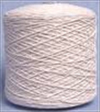
100%
pure cotton thread &
Linen thread

100%
Hemp yarn |
|
|
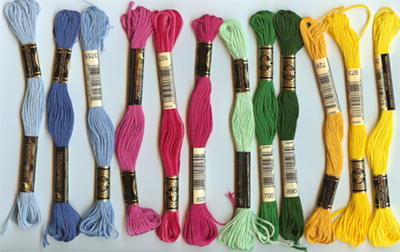
… Winter
Color ….… Spring color …. Summer color
…Autumn color |
| |
|
I prefer to tie the
Life
String© into sections representing the four seasons and
the 12 months and then go back later and add 13 knots of a totally
different color to represent the 13 moons of the year. Sometimes, I
use beads or puka* shells to represent the moons. I also prefer to
use three types of string to braid or tie together to represent the
three Fates. I have used Bamboo thread + Hemp thread + Cotton thread
and at every foot of the combined thread tied a foot long length of
the same combination to delineate each month. See the thread
picture.
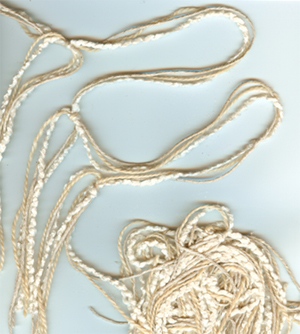 |
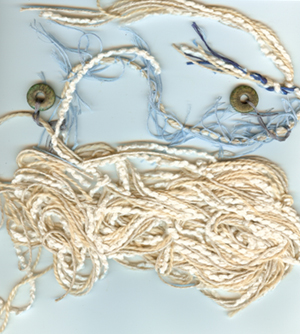 |
|
|
LifeString© 3-Fates thread of Bamboo, Hemp and Cotton The
thread is tied every foot with another
3-strand piece of thread. At Solstice and Equinox another in
appropriate color is braided in. Moons
are represented with puka* shells or puka* stones. |
LifeString© 3-Fates thread of
Bamboo, Hemp and Cotton – the 1st month (January) tied with
blue and showing puka* stones to represent the full moon of
December 07 and of January 2008. The tri-color strand in the
upper right represents Winter Solstice. |
|
With care and thought
and with your wish or desire clearly written out or thought out
ahead of time; tie the days of the year onto the ‘Life String©’. It
will take time. It should take time.
Be mindful of what
you are doing. Remember that a powerful ceremony is only as powerful
as the energy you put into it. Think of what you re doing and do it
with thought.
Make your
Ritual
circle with the Life String©
Mark a Circle, and within set up a square using a compass to mark
the directions. Set up four candles in the 4 corners to the 4
directions. Light the candles in the 4 corners and make the pot
ready to be lit. With the correctly chosen scent for incense and/or
burners - finally complete the circle with the Life String© making
sure the Seasons and the four directions are lined up correctly. Use
Blue/winter at North, yellow/Spring for East, green/Summer for South
and red/Autumn for West.
Background of the
String or Thread — Life String©
A thread generally symbolizes connecting one thing with another. In
some cultures it suggests the connection of this world and the next.
Time and life itself is a thread. By means of a thread you can find
your way from one place to another. Ariadne gave a ball of red
fleece thread to Theseus so that he could find his way out of the
labyrinth of the Minotaur.
The Fates
There are 3 Fates and they choose how long a person lives. They
have awesome power and symbolism. They are destiny.
Clotho, the spinner
is a goddess from Greek mythology. She is the spinner who spins the
thread of human life. She is the youngest of the Three Fates
(Clotho, Lachesis is the measurer, who chooses one’s destiny
and measures off how long life is to be, and Atropos “she who
can not be turned away” the cutter who determines the length
of life by cutting the thread to the correct length with her shears.
Atropos also determines the manner of death. Clotho is one of the
oldest goddesses in Greek mythology but the youngest of the Fates
while Atropos is the oldest.
Clotho is a daughter of
Zeus and Themis. Each Fate has a certain job, to spin it on a
spindle to measure thread, or to cut the thread at the right length.
…“Clotho is the spinner,
and she spins the thread of human life with her distaff. The length
of the string will determine how long a certain person's life will
be. She is also known to be the daughter of Night, to indicate the
darkness and obscurity of human destiny. No one knows for sure how
much power Clotho and her sisters have, however; they often disobey
the ruler, Zeus, and other gods. For some reason, the gods seem to
obey them, whether because the fates do possess greater power, or as
some sources suggest, their existence is part of the order of the
Universe, and this the gods cannot disturb.”…
Their father was Zeus
and their mother was Themis, the goddess of Order and the Divine
Right and represents the order of things as sanctioned by custom and
law. The Romans call her Justice and she is represented as a stern
looking woman, blindfolded and holding a pair of scales and a
cornucopia. Some say that the mother of the Fates is Night or Nyx
(by no one).
Symbols and Unknown
Words
*Puka means a hole
Sources: “Ritual
Works!” has bath salts, massage oils, essential oil blends, - all in
each color of the spectrum for your works. Special order form is at
the end of the
Ritual book.
Books are listed on the website,
the Calendar shows the classes
and the home-study courses are available in both
Aromatherapy and Herbal Studies.
www.JeanneRose.net
Bibliography:
Rose,
Jeanne,
Ritual • Works a Magical Experience.
Institute of Aromatic
Studies.
http://www.Jeanne Rose.net/
http://.pantheon.org/articles
www.vroma.org/ ~araia/lachesis.html
The Herder Symbol Dictionary by
Chiron Publications. 1988
The Dictionary of Symbols by Carl G. Liungman. Norton & Company. 1991
Rose, Jeanne.
The Aromatherapy
Book, Application & Inhalations
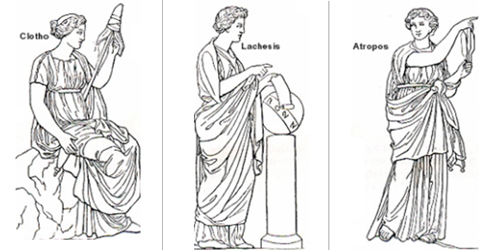 |
|
The Fates of
Life: Spinning, Counting/Measures, Cutting
|
|
Magic is just science
not yet known, not yet studied, not yet analyzed!
… Jeanne Rose, 2008
# # #
All rights reserved 2003, 2004, 2005, 2006. No part of this article may
be used without prior permission from Jeanne Rose.
© Authors Copyright Jeanne Rose,
info@jeannerose.net
|






